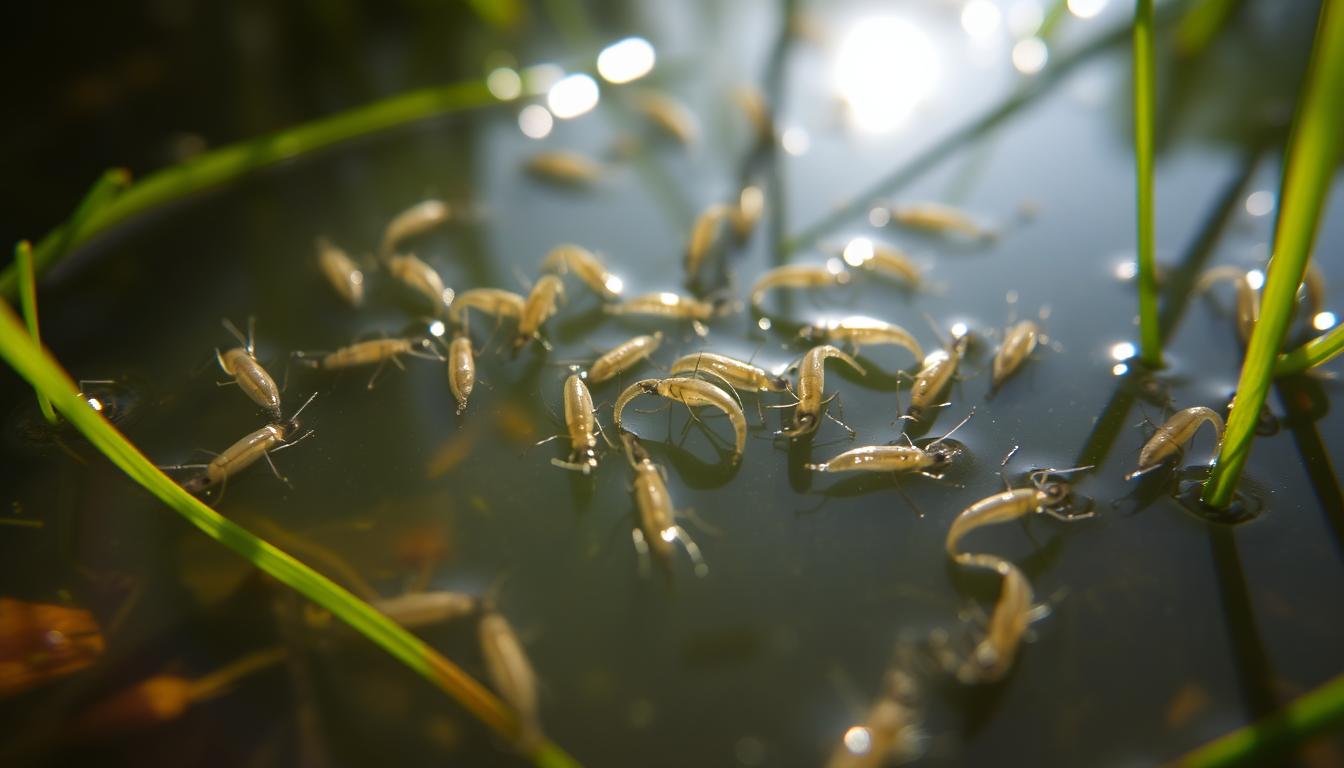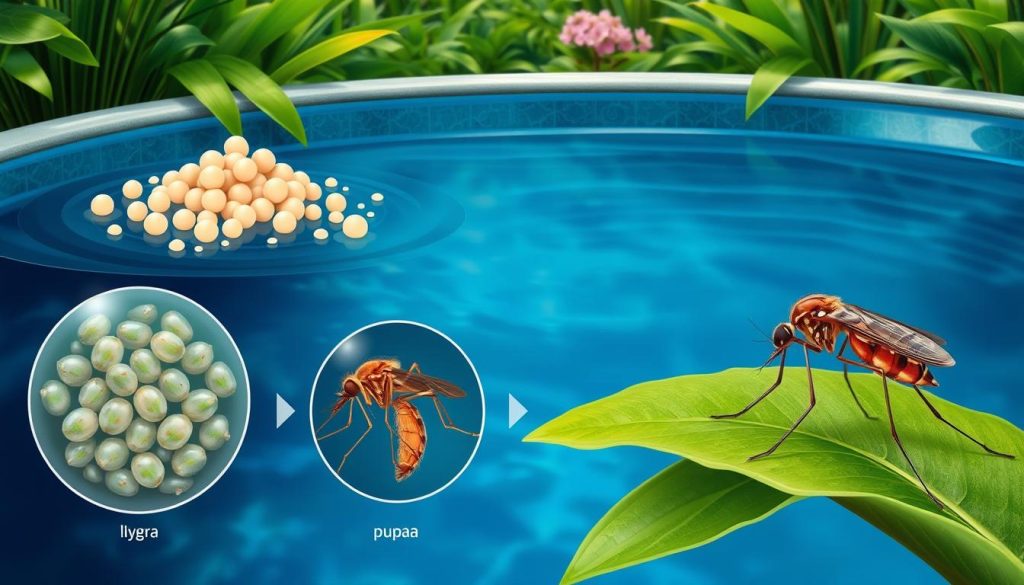
Mosquitoes carry diseases like Zika virus, West Nile virus, and dengue fever. They can turn your backyard into a breeding ground for larvae. This poses a health risk to your family.
Pool owners must control mosquito populations to prevent disease spread. One popular method is using pool shock as a larvicide. But how effective is this approach?
Mosquito larvae are small, slender, and about half an inch long. They thrive in stagnant water, making poorly maintained pools ideal breeding spots. Regular pool cleaning and chlorination can reduce larvae development.
Even with proper upkeep, these pests can still find their way into pools. Understanding their life cycle is key to effective control.
Understanding the Mosquito Life Cycle and Pool Infestation
Mosquitoes go through four stages: egg, larva, pupa, and adult. The first three stages need water to grow. Poorly maintained pools are perfect breeding spots for these pests.

Female mosquitoes lay up to 300 eggs in one area. They choose places with standing water like pools and ponds. The larvae need this water to survive and become adults.
Identifying Mosquito Larvae in Your Pool
Mosquito larvae, or wrigglers, are small, slender, and dark. They have a distinct head and a hairy, segmented body. You’ll often see them near the water’s surface.
These larvae breathe through a special tube called a siphon. Spotting them early helps prevent infestations and health risks from adult mosquitoes.
| Mosquito Larvae Characteristics | Identification Tips |
|---|---|
| Small, slender, and dark in color | Look for tiny, worm-like creatures in the water |
| Distinct head and segmented body | Observe the larvae’s body structure |
| Covered in tiny hairs | Notice the fine hairs on the larvae’s body |
| Found near the water’s surface | Check for larvae coming up to breathe |
| Breathe through a siphon tube | Look for the specialized breathing tube |
Health Risks Associated with Mosquito Larvae
Mosquito larvae in your pool can lead to serious health issues. Adult mosquitoes can spread diseases through their bites. These include Zika virus, West Nile virus, and dengue fever.
- Zika virus
- West Nile virus
- Dengue fever
- Malaria
- Chikungunya
Mosquito bites can cause itching and allergic reactions. Dealing with larvae in your pool reduces these health risks. It creates a safer outdoor space for everyone to enjoy.
Using Pool Shock to Kill Mosquito Larvae
Pool shock, or chlorine shock treatment, can be used to tackle mosquito larvae in your pool. It’s crucial to understand how chlorine affects larvae and the recommended levels for effective treatment.
How Chlorine Affects Mosquito Larvae
Chlorine harms the enzymes and internal structures of mosquito larvae, leading to their death. However, the needed concentration is much higher than typical pool levels.
Recommended Chlorine Levels for Effective Larvicide
Studies show that 250 parts per million (ppm) of chlorine can kill larvae within hours. Normal pool levels are 1-3 ppm. Regular pool chlorination alone may not control larvae populations effectively.
| Chlorine Level | Effect on Mosquito Larvae |
|---|---|
| 1-3 ppm | Insufficient for effective larvicide |
| ~250 ppm | Kills larvae within a few hours |
Alternative Methods for Eliminating Mosquito Larvae
Beyond chlorine shock treatment, other methods can control mosquito larvae in your pool. These include using bacterial larvicides and physically removing larvae through regular pool maintenance.
- Use bacterial larvicides like Bacillus thuringiensis israelensis (BTI), which specifically target mosquito larvae
- Physically remove larvae through regular pool brushing and scrubbing
- Apply mosquito larvicides according to the product label instructions
Proper pool maintenance is key to preventing mosquito infestations. This includes regular cleaning, chemical balance, and using pool covers when not in use.
- Regular cleaning and skimming
- Maintaining proper chemical balance
- Using pool covers when the pool is not in use
By implementing a combination of larvicide treatments and consistent pool maintenance, you can effectively control mosquito larvae and enjoy a mosquito-free swimming environment.
Use mosquito repellents and set up nets around the pool area. Ensure adequate lighting to deter adult mosquitoes and reduce future larvae infestations.
Conclusion
Proper chlorine levels are vital for pool health but may not fully control mosquitoes. Standard chlorine levels in home pools often can’t eliminate mosquito larvae. A comprehensive approach is needed for a mosquito-free pool.
This approach includes regular pool maintenance, environmental management, and targeted larvicide treatments. Understanding the mosquito life cycle and identifying larvae are crucial steps. Using specific larvicides and manual cleaning can greatly reduce mosquito risks.
Proper pool care prevents mosquito breeding and ensures a clean swimming environment. Stay vigilant in your pool maintenance and mosquito control efforts. This will help you enjoy a refreshing, healthy pool all season long.







